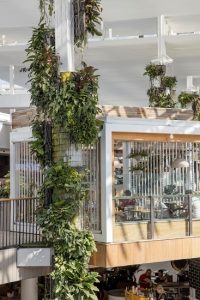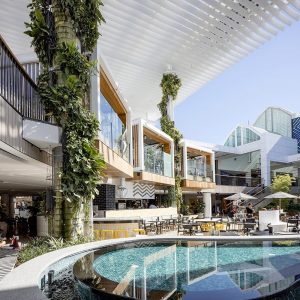While some climbing plants will cling directly to a wall surface, in a multi-storey building, a support structure is usually required to withstand wind and movement pressures and for protection of the wall.
Metal structures are generally more practical than either wooden or plastic ones for facades, because of their longevity, strength, wind-resistance and easier maintenance.
Of course it’s important that the building itself is able to withstand the weight and forces of a support structure. This means the structure needs to be carefully selected not only to meet client requirements, but also to match the building itself.
In a new building, this can be done at the design stage. In retrofit cases, the existing building will need to be thoroughly assessed to find the best solution for the particular site.
Considerations include the weight of dead loads (such as the final weight of the structure and all components), and transient loads such as wind and movement.
Green facade structure types
Examples of metal supports include stainless steel netting, steel and wire rope systems, and cabling and hybrid systems.
Whichever structure is chosen, precision engineering is required for best results. For example:
- Cables need to be pre-tensioned to 1-2 kilonewton or kN (with 1 kN equating to a load of approximately 100kg), and dead weight of plantings at 8kg per m2. The engineering also needs to allow for 80% porosity as plantings tend to let a lot of wind through.
- Mesh – needs to allow for 20kg weight per lineal metre with the rest of the loads as for cables.
- Hybrid – loads for these systems are the same as for cables, plus the weight of the planter units at 60-80kg/m2.

Common pitfalls
In many cases, facade structures are over-engineered, adding to the cost. For example, some cabling systems are engineered way beyond the climbing plant requirements per m2 of 8kg – sometimes even as high as 60kg!
Precision engineering, as opposed to estimating or guessing, helps to avoid the extra expense that over-engineering can create.
A case in point – Warringah Mall Brookvale NSW
Tensile’s know-how and experience means the team can design a precision solution to get the job done without over-engineering. One example is the Warringah Mall project, which involved the installation of a hybrid facade of planter units, and columns up to 14 metres in height.
These are suspended from cables rated to take up to 400kgs. The entire system was wrapped in Webnet mesh, and applies 20kg per pre tension. The system was engineered for 14-18 plant units per column – which eventually will become covered in greenery.
Precision solutions with Tensile
Our team carries out an accurate and precise assessment of projects to arrive at the best solution for a green support structure.
We can design and engineer the green facade structure ourselves, or complement a consultant team. Contact us to find out more about our support structures for green façades.






































